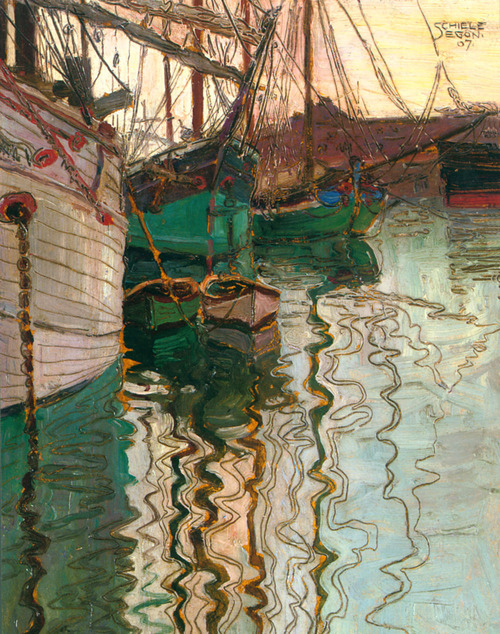Family and Father’s Death
Self Portrait with Palette, 1905 |
Dead Mother Portraits
 |
| Dead Mother I, 1910 |
 |
| Dead Mother II, 1911 |
Family and the Railway Industry
Schiele’s family was heavily involved in the railway industry. His father, Adolf, was in charge of an important railway station, one of his grandfather’s was a “railway builder of genius” and his uncle who was his godfather and later Schiele’s guardian as well was a railway engineer. Schiele had two sisters Gerti and Melanie. Melanie, the elder, worked in the railway industry her entire life and married a railway executive. Thus it makes sense that many of Schiele’s early drawings are of trains.
Schiele and Gerti and Mirrors
“Have adults forgotten how depraved, i.e., how sexually stimulated and excited, they were themselves as children? Have they forgotten how the terrible passion burned within them and tortured them when they were still children? I have never forgotten it, for I suffered from it dreadfully.” Schiele’s relationship with Gerti is said to have replaced in a way his relationship to his mother. They had a sexualized relationship - Gerti even modeled nude for Schiele. It is also said that Schiele turned to mirrors as a way to supplement his loss of a motherly figure in his life. It is said that he looked at himself in every mirror he saw, examining his facial features and he even began to carry full length mirrors many places he went later in his life. The mirror allowed Schiele to heal himself and express him at the same time and all by himself.
 |
| Gerti In a Plaid Garment, |
“Have adults forgotten how depraved, i.e., how sexually stimulated and excited, they were themselves as children? Have they forgotten how the terrible passion burned within them and tortured them when they were still children? I have never forgotten it, for I suffered from it dreadfully.” Schiele’s relationship with Gerti is said to have replaced in a way his relationship to his mother. They had a sexualized relationship - Gerti even modeled nude for Schiele. It is also said that Schiele turned to mirrors as a way to supplement his loss of a motherly figure in his life. It is said that he looked at himself in every mirror he saw, examining his facial features and he even began to carry full length mirrors many places he went later in his life. The mirror allowed Schiele to heal himself and express him at the same time and all by himself.
Artistic Encouragement/discouragement from his family
Schiele’s father wished for Schiele to follow in his footsteps or at least to work for the State where there would be security and respect. His godfather and guardian after Adolf passed away, Leopold Czihaczek, also discouraged Schiele from artistic endeavors - even more strongly than his father had. Czihaczek was more involved in the railway business and had a greater appreciation for music than the visual arts.
Personality
Schiele was known as a child as lonely and withdrawn, often daydreaming. He often felt misunderstood by his teachers and classmates. He has also been described as being self-obsessed and narcissistic.
Ludwig Karl Strauch was Schiele’s first art teacher who began working with him in 1905. Accounts are mixed as to Strauch’s influence on Schiele - some report him as being a helpful positive influence, others say he tried to negatively change Schiele’s personal style. He did, however, allow Schiele the unique privilege of working in his home studio as well as was influential in convincing Schiele’s mother to allow Schiele to apply for art school - the Kunstgewerberschule. However because of various possible reasons, this school told him to apply to the Academy of which he was accepted and began studying at in 1906, so at the age of 16. His drawings at the academy were merely “satisfactory” for the most part and did not go beyond mere representation. Schiele’s main professor at the academy, Griepenkerl, was extremely focused on traditional techniques and subjects and disliked any waywardness in his pupils. Thus, Schiele and Griepenkerl did not get along well at all. Even with all of Griepenkerl’s warning against associating with or meeting with members of the succession and especially Klimt, Schiele is thought to have met with Kilmt as early as 1907. Almost immediately following, Klimt’s influence can be seen in some of Schiele’s work. Klimt became influential in aiding Schiele to produce work and helped him in ways such as buying some of his drawings or arranging models or patrons.
Wiener Werkstatte - 1908
Schiele began working for the Wiener Werkstatte, “a business organized to produce and sell arts and crafts of all kinds”, in 1908 upon being introduced to them by Klimt. He also got his sister, Gerti, a job as clothing model.
The end of his childhood
Schieie’s childhood is usually marked as ending with the transition from his portraits that begin to address his identity crisis. These images, beginning to appear in 1910, depict Schiele nude and express self-discovery and exhibitionism - many also express him coming to terms with his masculinity and were highly sexualized. They were both unexpected and quite shocking to the general public even at a time when self-portraiture was becoming increasingly popular.
